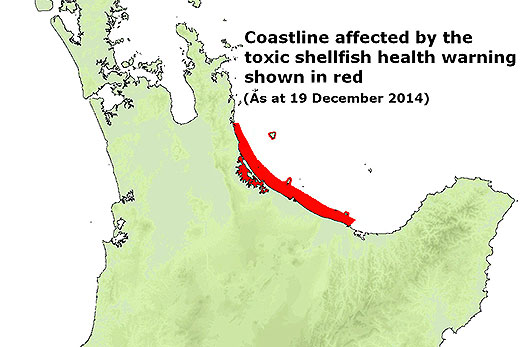The Paralytic Shellfish Poisoning warning issued for the Bay of Plenty is now being extended along the Coromandel Peninsula to the southern end of Whangamata beach.
The affected area now includes the entire coastline from Whakatane Heads in the Eastern Bay of Plenty, all the way along the coast to Waihi Beach, and up the eastern side of the Coromandel Peninsula to the river at the southern end of Whangamata beach.
A map showing the affected areas.
All harbours, estuaries and islands along this coastline are included in the warning.
'Ongoing monitoring has shown high levels of paralytic shellfish poison present in shellfish along this coastline,” says Medical Officer of Health Dr Phil Shoemack.
'Shellfish in the affected area should not be taken or eaten.”
The health warning applies to all bi-valve shellfish including mussels, pipi, tuatua, cockles, oysters, scallops as well as cat's eyes, snails and kina (sea urchin).
Phil says PSP is caused by natural toxins that are produced by algal blooms and accumulate in shellfish that feed on the algae.
Shellfish containing toxic levels of paralytic shellfish poison don't look or taste any different from shellfish that are safe to eat.
Cooking or freezing the shellfish does not remove the toxin.
Paua, crayfish and crabs can still be taken but as always, the gut should be removed before cooking or eating.
'In the last two weeks, 12 people have been reported to Toi Te Ora – Public Health Service with paralytic shellfish poisoning,” says Phil.
'Eating shellfish affected by paralytic shellfish toxin can cause numbness and tingling around the mouth, face, hands and feet; difficulty swallowing or breathing; dizziness; double vision; and in severe cases, paralysis and respiratory failure.”
Phil adds: 'These symptoms can start as soon as 1-2 hours after eating toxic shellfish and usually within 12 hours. Anyone suffering illness after eating shellfish should seek urgent medical attention.”
Monitoring of toxin levels will continue along the coast and any changes in advice will be communicated accordingly.
The public can obtain up-to-date information on the toxic shellfish health warning through these channels:
Phone: 0800 221 555
Website: www.ttophs.govt.nz/health_warnings
Twitter: www.twitter.com/ttophs
Email alerts for subscribers: www.ttophs.govt.nz/alert
Signage at locations



0 comments
Leave a Comment
You must be logged in to make a comment.